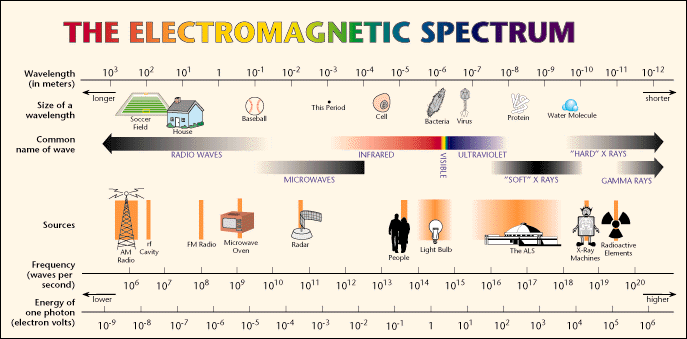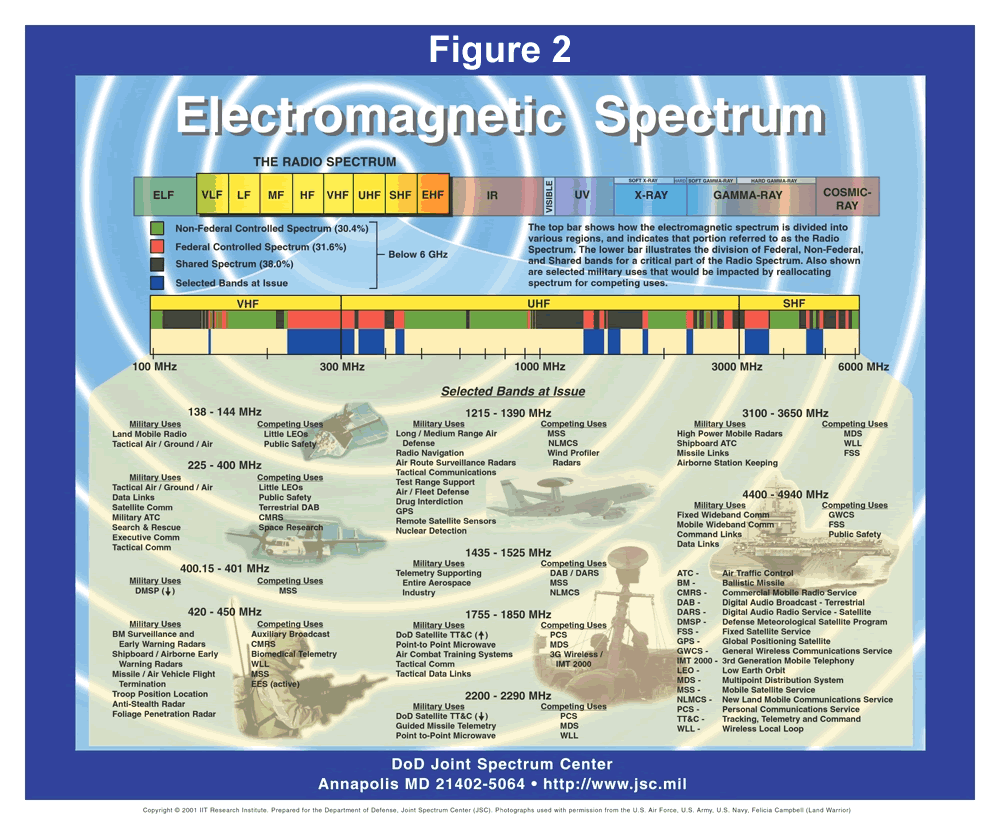
Electromagnetic (EM) radiation exists in a large range of frequencies and wavelengths as you can see in the figure below (courtesy Prof. Julien Clinton, University of Wisconsin). This range is called the electromagnetic spectrum.

All electromagnetic radiation has characteristics of waves and particles (photons) . The wave properties are more apparent at lower frequencies while the "rays" of higher frequencies have more obvious particle behaviors. We will focus on the radio waves. (Note that the visible part of the spectrum is very small).
Notice that there is a one-to-one relationship between wavelength, frequency and energy of one photon. Higher frequencies correspond to shorter wavelengths and higher energy photons.
Radio Waves and Microwaves
This type of radiation travels easily through the atmosphere and clouds. It
is generated by accelerating electrons in antennas. Microwaves are usually considered
to be a subset of radio waves. A majority of this class will be devoted to how
the atmosphere affects these waves.
Infrared Radiation
This type of radiation is emitted by all matter that is at typical temperatures
found on the earth's surface and atmosphere. Infrared radiation is absorbed
by clouds and solid objects. Some infrared wavelengths travel long distances
through the clear atmosphere while other wavelengths are absorbed in a few meters.
Visible Radiation
This is the main type of radiation that is emitted by the sun, other very hot
objects such as incandescent light bulbs and from excited atoms in lasers and
florescent light bulbs. It travels quite easily through the clear atmosphere.
This is the only type of EM radiation that can be seen by people.
Ultraviolet Radiation
This is also emitted by the sun and other high energy (high temperature) sources.
Most of it is absorbed in the upper atmosphere. It can travel a short distance
into some solid objects such as skin, which is why it causes sun burns.
X-Rays
These are emitted by very high energy sources such as supernovas, radioactive
material, and x-ray machines. They can travel some distance through many solid
objects, making them useful for detection of contraband and for medical uses.
They are virtually unaffected by the atmosphere.
Gamma Rays
These are emitted by extremely high energy sources such as nuclear explosions,
and gases being sucked into black holes. They can travel great distances through
solid objects and are very harmful to people. They are unaffected by the atmosphere.

The image above shows only a few of the uses and frequency locations employed for military uses. As you can see, the military uses many different locations within the EM spectrum. Notice that radio waves (which also include microwaves) have there own spectrum and are divided into several bands: ELF, ULF, VLF, LF, MF, HF, VHF, UHF, VHF and SHF. For now, you just need to know that these bands represent different radio frequency ranges. In later modules, we will discuss the characteristics and details of these different radio bands.
The EM spectrum encompasses a large range of wavelengths and frequencies. The military uses many different regions within the EM spectrum.
Test your knowledge by taking the quiz. The quiz will open in a new page or tab so that you can refer back to this page if you need to. You may do the quizzes for each module as many times as you like, just hit the refresh button on your browser to clear your answers. When you are done, continue to the next module by clicking the "Next" button at the bottom right of this page.